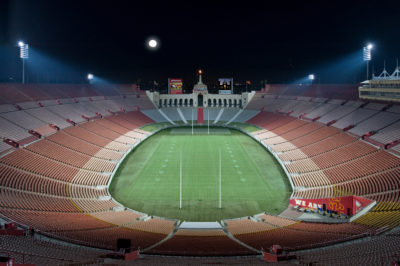Much of Los Angeles is outsize, and people like it that way. The L.A. Memorial Coliseum, home to USC football and - temporarily - the Los Angeles Rams, is an excellent case in point.
The outdoor sports stadium has long occupied a spot in the Los Angeles skyline, completed in 1923 as a memorial to Los Angeles veterans of WWI. It holds the distinction of being one of just a handful of National Historic Landmarks in Los Angeles and, in 2028, will become the only stadium in the world to have hosted the Olympics three times. It earned its national landmark status in 1984, the day before the opening ceremony of the second Olympics to take place on its field. When the University of Southern California took over the master lease of the historic Coliseum in 2013, they began planning for an extensive renovation and remodeling project. While the structure has been renovated several times over its nearly 100 years, the most recent update at that point was about 20 years prior, in response to the 1994 Northridge earthquake. Beneath the facade, the technology was severely in need of an update.
The $315 million renovation project required a team of architects, engineers, and integrators to construct a brand-new, seven-story tower without alteration to the historic veneer. The renovation also needed to deliver a complete modernization of technology, including LED ribbon boards, a new sound system, stadium-wide Wi-Fi, two new large-screen video displays, and an updated scoreboard, and modernization of all lighting, plumbing, and electrical systems. The facility has played host to the Olympics, the World Series, and multiple Super bowls; countless political dignitaries and pop culture icons have graced its field. But with the third Los Angeles-area Olympics slated for 2028, the stadium needed a complete rethink of premium space, including the addition of the 3,000-seat, seven-story Scholarship Club Tower at midfield- plus, an additional 235,000 square feet of space incorporated into the existing bowl.
On Aug. 24, 2019, crowds filed into the new stadium, and longtime fans certainly noticed the improved experience the technology upgrades provide, even if they couldn't put their finger on precisely what seemed better. And the team at Rosendin was breathing sighs of relief that somehow, despite the challenges and setbacks, they had pulled off one for the ages.


